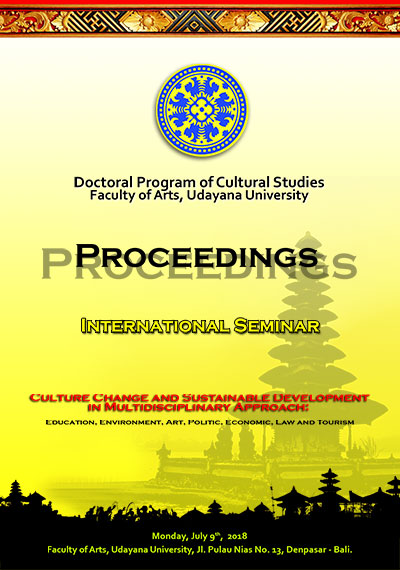RELATIONSHIP OF KNOWLEDGE POWER TO THE CAR SHAPED THRONE IN PALUANG TEMPLE, NUSA PENIDA, KLUNGKUNG BALI
Abstract
The design of throne cars shaped is a new phenomenon in the architecture of Balinese worship. This unique phenomenon can be seen in Paluang Temple Nusa Penida. Two car shaped shrines Beatle VW and Jimny Jeep, dedicated to worship Ida Betara Ratu Gede Sakti Hyang Mami and his retinue. This study aims to reveal the power of knowledge relation on the design of the car shaped shrine. This study uses qualitative method with analytical descriptive approach. Data collection with observation and documentation. Informant determination was done by purposive sampling. Data analysis is based on power of knowledge relation, and power of discipline theory. The findings of this study reveal the strong power of knowledge relation in the myths developed by organic intellectuals (spiritual and indigenous leaders). The knowledge behind the myth is captured and developed as a power through media car shaped throne. The power relations discipline, work to discipline the body of Karang Dawa village community in the practice of worship in both shrines and other shrines in Paluang Temple, as the fulfillment of desire and expectation. The car shaped throne is a religious sign. In this millennial era, the globalization of media information has a lerated and expanded the consumption of the sign, not only limited in the area of Nusa Penida Bali, but has expanded throughout the world, through the role of capitalist actors who capture the knowledge behind the existence of the two cars shaped shrine to be a power in commercial realm.
Downloads
References
Barker, Chris. 2005. Cultural Studies: Theory and Practice. Cover. Yogyakarta: PT. Span Library. Benvenuto, Bice and Roger Kennedy. 1986. The Works of Jacques Lacan: An Introduction. New York: St. Martin's Press.
Danesi, Marcel. 2012. Messages, Signs, and Meanings. Basic Textbook Concerning Semiotics and Communication Theory. Yogyakarta: Jalasutra.
Dhika, Andye. 2015. "Symbolism and Religion, Symbols in Religion" (access dated May 21, 2018). Available in URL: https://sumber-ilmu-islam.blogspot.co.id/2015/ 06 / symbolism-andreligion-symbol-in-religion.html.)
Dillstone, 2002. The Power of Symbols. Power of Symbols. Yogyakarta, Kanisius. Dwijendra, Ngakan Ketut Acwin. 2008. Architecture of Hindu Sacred Building Based on Asta KosalaKosali. Denpasar: CV. Bali Media Adhikarsa and Udayana University Press.
Eriyanto, 2005. Framing Analysis: Construction, Ideology and Politics Media. Yogyakarta: PT LkiS Pelangi Aksara.
Foucault, Michel. 2002. Power / Knowledge, Discourse of Power / Knowledge. Cover. Yudi Santosa. Yogyakarta: Cultural landscape.
Lubis, Akhyar Yusuf. 2014. Postmodernism Theory and Method. Jakarta: Rajawali Pres. Lucy, Niall. 1995. Social Semiotics. Perth: Murdoch University. Piliang, Yasraf Amir. 2003. Hypersemiotics: Tafsir Cultural Studies On Death Meaning. Yogyakarta: Jalasutra.
_______and Jejen Jaelani. 2018. Contemporary Cultural Theory: Exploration of Signs and Meanings. Yogyakarta: Aurora.
Putranto, Hendar. 2009. Cultural Analysis of Postmodernism and Postmodernity. In the book Theories of Culture, Editor Mudji Sutrisno and Hendar Putranto. Yogyakarta: Kanisius.
Rabate, Jean-Michel. 2003. The Cambridge Companion to Lacan. New York: Cambridge University Press. Ratna, Nyoman Kutha. 2010. Research Methodology of Cultural Studies and Social Sciences of Humanities in General. Yogyakarta: Student Literature.
Thompson, John B. 2003. The Critique of Global Ideology. Haqqul Yagin Translation. Yogyakarta: IPCiSoD.
Team Compilers, 2009. Asta Kosala Kosali, Asta Bhumi. Denpasar: Cultural Office of Bali Provincial Government.
Zoetmulder, P.J. Dictionary of Java Kuna-Indonesia. Jakarta: PT. Gramedia Pustaka Utama.

This work is licensed under a Creative Commons Attribution-NonCommercial-ShareAlike 4.0 International License.





